Ideal Protein and amino acids for gestating sows
Application of Ideal Protein and Amino Acid Requirements for Gestating Sows
Published: February 2, 2011
By: Sung Woo Kim, Alexandra Chaytor, Yanbin Shen and Gwendoline Voilque (North Carolina State University)
INTRODUCTION
Sows are under nutritionally catabolic status during late gestation and lactation especially due to limited protein intake and increased needs for protein to support the growth of fetal tissues (McPherson et al., 2004), mammary parenchymal tissues (Kim et al., 1999; Ji et al., 2006), and milk synthesis (Revell et al., 1998; Jones and Stahly, 1999). The maternal catabolic conditions impair the growth of the fetus and the neonate as well as increase their morbidity and mortality (Wu et al., 2006). Under limited protein intake especially during late gestation and during lactation, providing amino acids that are ideally balanced for maximal utilization efficiency would be important.
In establishing ideal protein for gestating sows, there are important factors to consider: (1) amino acids needed for fetal growth, (2) amino acids needed for mammary tissue growth, and (3) amino acids needed for maternal tissue growth in case of young sows. Changes in the amounts and compositions of amino acids gained in fetal, mammary, and maternal tissues will affect ideal amino acid pattern for gestating sows.
Recent studies measured growth patterns of fetuses (McPherson et al., 2004), mammary glands (Ji et al., 2006), and maternal tissues (Ji et al., 2005) of modern lean-type prolific sows. It was clear that growth of fetuses and mammary glands occurred mostly during late gestation. Based on these results, ideal protein was established for gestating sows (Kim et al., 2009). However, these studies were done under a specific condition and thus suggested amino acid requirement and ideal protein apply only to a condition given in these studies. The purpose of this article is to provide tools to apply the information provided from these studies under various conditions.
PROTEIN AND AMINO ACID REQUIREMENTS FOR PREGNANT SOWS
Amino acid requirements for gestating sows depend on the number of fetuses (McPherson et al., 2004), mammary glands (Kim et al., 1999; Ji et al., 2006), maternal growth potential (Ji et al., 2005), and maintenance needs (NRC, 1998). These components will affect ideal protein for gestating sows as well. Kim et al. (2009) has determined amino acid requirements and ideal protein for gestating sows based on the amounts of amino acids accreted in fetal, mammary, and maternal tissues during different stage of gestation with an estimation of amino acid needs for maintenance from NRC (1998). Requirement of true ileal digestible Lys, as an example, was greatly increased from 6.8 g/d for early gestation (d 0 to 70) to 15.3 g/d for late gestation (d 70 to farrowing). Requirements of other amino acids can be calculated based on ideal protein suggested by Kim et al. (2009) as shown in Table 1. Suggested amino acid requirements by Kim et al. (2009) are based on gilts (or primiparous sows) with 160 kg BW at breeding, high lean gain potential, 14 fetuses, and 16 mammary glands. Sows gained 60 kg BW during gestation (Ji et al., 2005).
Sows with different BW, fetal litter sizes, and numbers of mammary gland would have different amino acid requirements due to alternation in needs for amino acids to support the growth of tissues and the maintenance. Suggested amino acid requirements can be adjusted for sows under different conditions. Amino acid needs for fetal growth are shown in Table 2 which is based on needs for individual fetus (McPherson et al., 2004; Kim et al., 2009). The average litter size of sows used in this study was 12 fetuses with an average BW of 1.47 kg/fetus at d 110 of gestation. Average BW at birth can be estimated as 1.55 kg/pig.
Amino acid needs for mammary gland growth are shown in Table 3 which is based on needs for individual mammary gland (Ji et al., 2006; Kim et al., 2009). The average number of mammary glands in this study was 15 with an average weight of 300 g/gland at d 110 of gestation. Average weight at birth is 360 g/gland (Kim et al., 1999).
Amino acid needs for maternal gain and maintenance (excluding needs for fetuses and mammary glands) are shown in Table 4. The values are for sows with BW of 160 kg at breeding, 195 kg at d 70 of gestation, and 220 kg at d 114 of gestation (Ji et al., 2005). Lys needs for maintenance in the early and late gestation were calculated using 36 mg/BW0.75 kg (NRC, 1998) where BW was the average adjusted BW of each phase; 7) the needs of other essential AA for maintenance were calculated from the true ileal digestible Lys need and the Lys-based AA ratios for maintenance suggested by NRC (1998).
SIMULATION OF AMINO ACID NEEDS FOR SOWS
Using the data shown in Table 1-4, amino acids needs for sows under various conditions can be estimated. Amino acid needs for sows with various fetal numbers are simulated in Table 5. Increase in the number of fetuses increase amino acid requirements for gestation sows especially during late gestation due to rapid growth of fetuses occurring during late gestation. Ideal protein also changes as fetal number changed (Table 6). Relative ratio of Thr and Ile to Lys reduced as the number of fetuses increased whereas other essential amino acid had increased ratio relative to Lys. Similarly, estimates can also be made for multiparous sows with various BW and various maternal gain, for different number of mammary glands, for different birth weight of piglets, etc.
CONCLUSION
The amounts of amino acids required for protein accretion and maintenance were summed to obtain the amino acid needs for pregnant sows and then converted to Lys-based amino acid ratios. Amino acids requirements for gestating sows are different between early and late gestation and these requirements can also be affected by the number of fetuses, number of mammary glands, BW of sows, and maternal protein gain during gestation. Utilizing information published in Kim et al. (1999; 2009), McPherson et al. (2004), Ji et al. (2005; 2006), amino acid requirements can be estimated for gestating sows with various conditions.
LITERATURE CITED
Ji, F., G. Wu, J. R. Blanton, Jr, and S. W. Kim. 2005. Changes in weight and composition in various tissues of pregnant gilts and their nutritional implication. J. Anim. Sci. 83:366-375.
Ji, F., W. L. Hurley, and S. W. Kim. 2006. Characterization of mammary gland development in pregnant gilts. J. Anim. Sci. 84:579-587.
Jones, D. B. and T. S. Stahly. 1999. Impact of amino acid nutrition during lactation on body nutrient mobilization and milk nutrient output in primiparous sows. J. Anim. Sci. 77:1513-1522.
Kim, S. W., W. L. Hurley, I. K. Han, and R. A. Easter. 1999. Changes in tissue composition associated with mammary gland growth during lactation in the sow. J. Anim. Sci. 77:2510-2516.
Kim, S. W., W. L. Hurley, G. Wu, and F. Ji. 2009. Ideal amino acid balance for sows during gestation and lactation. J. Anim. Sci. 87:E123-E132.
Mahan, D. C., and R. G. Shields, Jr. 1998. Essential and nonessential amino acid composition of pigs from birth to 145 kilograms of body weight, and comparison to other studies. J. Anim. Sci. 76:513-521.
McPherson, R. L., F. Ji, G. Wu, J. R. Blanton, Jr., and S. W. Kim. 2004. Growth and compositional changes of fetal tissues in pigs. J. Anim. Sci. 82:2534-2540.
NRC, 1998. Nutrient Requirements of Swine (10th Ed). National Academy Press, Washington, DC.
Revell, D. K., I. H. Williams, B. P. Mullan, J. L. Ranford, and R. J. Smits. 1998. Body composition at farrowing and and nutrition during lactation affect the performance of primiparous sows: II. Milk composition, milk yield, and pig growth. J. Anim. Sci. 76:1738-1743.
Sows are under nutritionally catabolic status during late gestation and lactation especially due to limited protein intake and increased needs for protein to support the growth of fetal tissues (McPherson et al., 2004), mammary parenchymal tissues (Kim et al., 1999; Ji et al., 2006), and milk synthesis (Revell et al., 1998; Jones and Stahly, 1999). The maternal catabolic conditions impair the growth of the fetus and the neonate as well as increase their morbidity and mortality (Wu et al., 2006). Under limited protein intake especially during late gestation and during lactation, providing amino acids that are ideally balanced for maximal utilization efficiency would be important.
In establishing ideal protein for gestating sows, there are important factors to consider: (1) amino acids needed for fetal growth, (2) amino acids needed for mammary tissue growth, and (3) amino acids needed for maternal tissue growth in case of young sows. Changes in the amounts and compositions of amino acids gained in fetal, mammary, and maternal tissues will affect ideal amino acid pattern for gestating sows.
Recent studies measured growth patterns of fetuses (McPherson et al., 2004), mammary glands (Ji et al., 2006), and maternal tissues (Ji et al., 2005) of modern lean-type prolific sows. It was clear that growth of fetuses and mammary glands occurred mostly during late gestation. Based on these results, ideal protein was established for gestating sows (Kim et al., 2009). However, these studies were done under a specific condition and thus suggested amino acid requirement and ideal protein apply only to a condition given in these studies. The purpose of this article is to provide tools to apply the information provided from these studies under various conditions.
PROTEIN AND AMINO ACID REQUIREMENTS FOR PREGNANT SOWS
Amino acid requirements for gestating sows depend on the number of fetuses (McPherson et al., 2004), mammary glands (Kim et al., 1999; Ji et al., 2006), maternal growth potential (Ji et al., 2005), and maintenance needs (NRC, 1998). These components will affect ideal protein for gestating sows as well. Kim et al. (2009) has determined amino acid requirements and ideal protein for gestating sows based on the amounts of amino acids accreted in fetal, mammary, and maternal tissues during different stage of gestation with an estimation of amino acid needs for maintenance from NRC (1998). Requirement of true ileal digestible Lys, as an example, was greatly increased from 6.8 g/d for early gestation (d 0 to 70) to 15.3 g/d for late gestation (d 70 to farrowing). Requirements of other amino acids can be calculated based on ideal protein suggested by Kim et al. (2009) as shown in Table 1. Suggested amino acid requirements by Kim et al. (2009) are based on gilts (or primiparous sows) with 160 kg BW at breeding, high lean gain potential, 14 fetuses, and 16 mammary glands. Sows gained 60 kg BW during gestation (Ji et al., 2005).
Sows with different BW, fetal litter sizes, and numbers of mammary gland would have different amino acid requirements due to alternation in needs for amino acids to support the growth of tissues and the maintenance. Suggested amino acid requirements can be adjusted for sows under different conditions. Amino acid needs for fetal growth are shown in Table 2 which is based on needs for individual fetus (McPherson et al., 2004; Kim et al., 2009). The average litter size of sows used in this study was 12 fetuses with an average BW of 1.47 kg/fetus at d 110 of gestation. Average BW at birth can be estimated as 1.55 kg/pig.
Amino acid needs for mammary gland growth are shown in Table 3 which is based on needs for individual mammary gland (Ji et al., 2006; Kim et al., 2009). The average number of mammary glands in this study was 15 with an average weight of 300 g/gland at d 110 of gestation. Average weight at birth is 360 g/gland (Kim et al., 1999).
Amino acid needs for maternal gain and maintenance (excluding needs for fetuses and mammary glands) are shown in Table 4. The values are for sows with BW of 160 kg at breeding, 195 kg at d 70 of gestation, and 220 kg at d 114 of gestation (Ji et al., 2005). Lys needs for maintenance in the early and late gestation were calculated using 36 mg/BW0.75 kg (NRC, 1998) where BW was the average adjusted BW of each phase; 7) the needs of other essential AA for maintenance were calculated from the true ileal digestible Lys need and the Lys-based AA ratios for maintenance suggested by NRC (1998).
SIMULATION OF AMINO ACID NEEDS FOR SOWS
Using the data shown in Table 1-4, amino acids needs for sows under various conditions can be estimated. Amino acid needs for sows with various fetal numbers are simulated in Table 5. Increase in the number of fetuses increase amino acid requirements for gestation sows especially during late gestation due to rapid growth of fetuses occurring during late gestation. Ideal protein also changes as fetal number changed (Table 6). Relative ratio of Thr and Ile to Lys reduced as the number of fetuses increased whereas other essential amino acid had increased ratio relative to Lys. Similarly, estimates can also be made for multiparous sows with various BW and various maternal gain, for different number of mammary glands, for different birth weight of piglets, etc.
CONCLUSION
The amounts of amino acids required for protein accretion and maintenance were summed to obtain the amino acid needs for pregnant sows and then converted to Lys-based amino acid ratios. Amino acids requirements for gestating sows are different between early and late gestation and these requirements can also be affected by the number of fetuses, number of mammary glands, BW of sows, and maternal protein gain during gestation. Utilizing information published in Kim et al. (1999; 2009), McPherson et al. (2004), Ji et al. (2005; 2006), amino acid requirements can be estimated for gestating sows with various conditions.
LITERATURE CITED
Ji, F., G. Wu, J. R. Blanton, Jr, and S. W. Kim. 2005. Changes in weight and composition in various tissues of pregnant gilts and their nutritional implication. J. Anim. Sci. 83:366-375.
Ji, F., W. L. Hurley, and S. W. Kim. 2006. Characterization of mammary gland development in pregnant gilts. J. Anim. Sci. 84:579-587.
Jones, D. B. and T. S. Stahly. 1999. Impact of amino acid nutrition during lactation on body nutrient mobilization and milk nutrient output in primiparous sows. J. Anim. Sci. 77:1513-1522.
Kim, S. W., W. L. Hurley, I. K. Han, and R. A. Easter. 1999. Changes in tissue composition associated with mammary gland growth during lactation in the sow. J. Anim. Sci. 77:2510-2516.
Kim, S. W., W. L. Hurley, G. Wu, and F. Ji. 2009. Ideal amino acid balance for sows during gestation and lactation. J. Anim. Sci. 87:E123-E132.
Mahan, D. C., and R. G. Shields, Jr. 1998. Essential and nonessential amino acid composition of pigs from birth to 145 kilograms of body weight, and comparison to other studies. J. Anim. Sci. 76:513-521.
McPherson, R. L., F. Ji, G. Wu, J. R. Blanton, Jr., and S. W. Kim. 2004. Growth and compositional changes of fetal tissues in pigs. J. Anim. Sci. 82:2534-2540.
NRC, 1998. Nutrient Requirements of Swine (10th Ed). National Academy Press, Washington, DC.
Revell, D. K., I. H. Williams, B. P. Mullan, J. L. Ranford, and R. J. Smits. 1998. Body composition at farrowing and and nutrition during lactation affect the performance of primiparous sows: II. Milk composition, milk yield, and pig growth. J. Anim. Sci. 76:1738-1743.
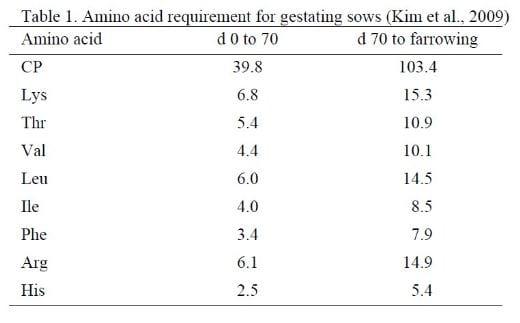
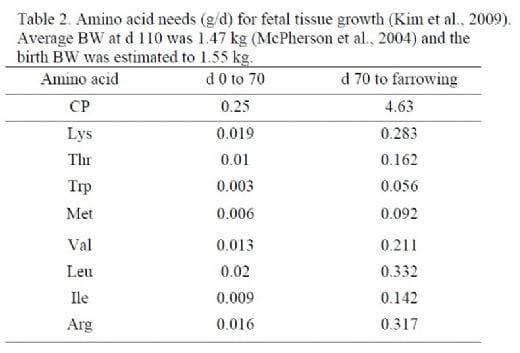
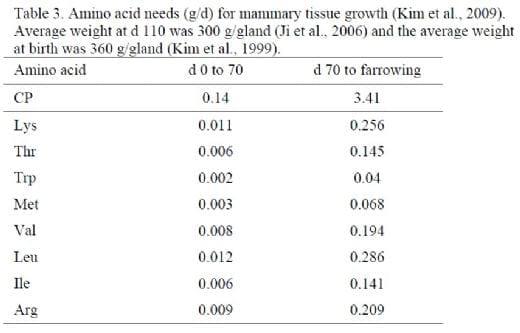
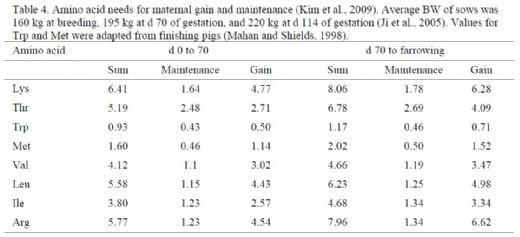

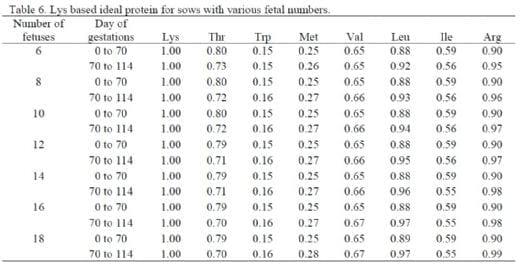
This presentation was given at IV CLANA 2010, Brazil. Engormix.com thanks the author and the organizing committee for the huge contribution.
Related topics
Authors:
Join to be able to comment.
Once you join Engormix, you will be able to participate in all content and forums.
* Required information
Would you like to discuss another topic? Create a new post to engage with experts in the community.
Create a post





